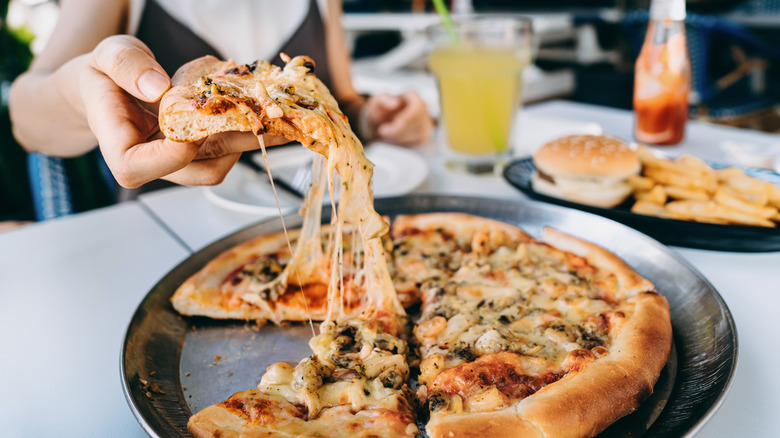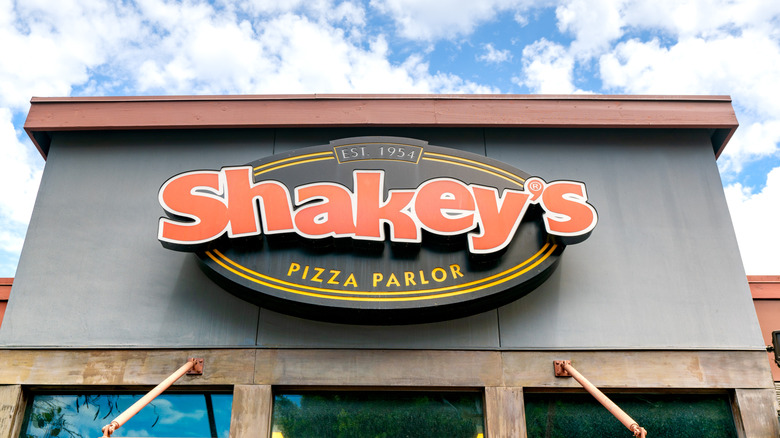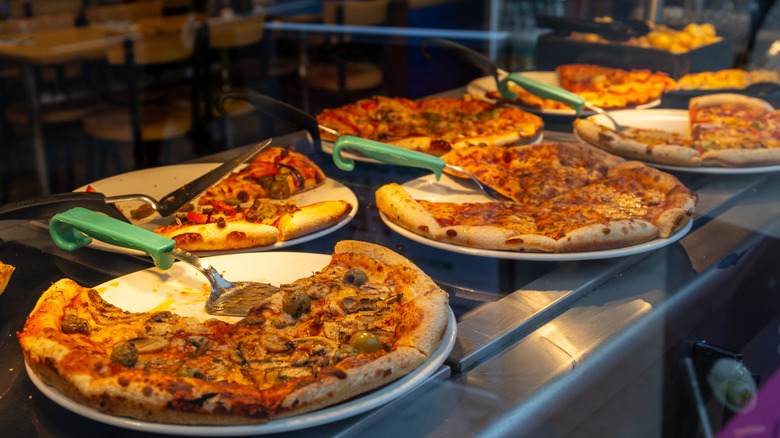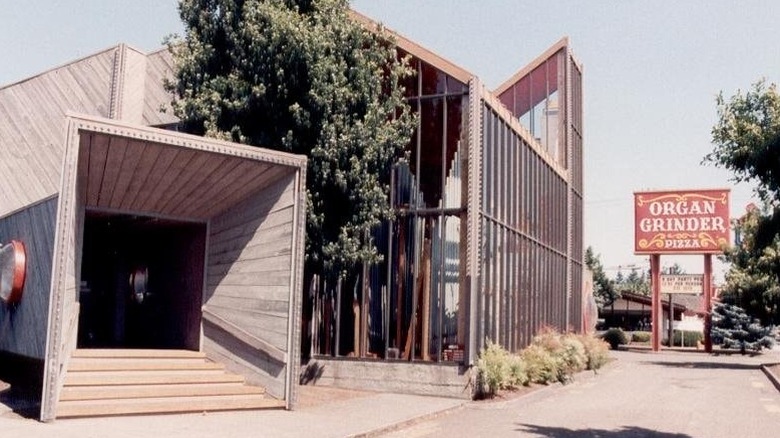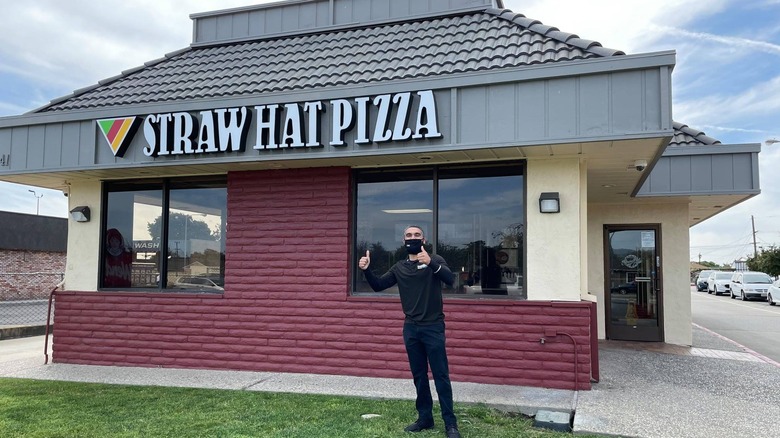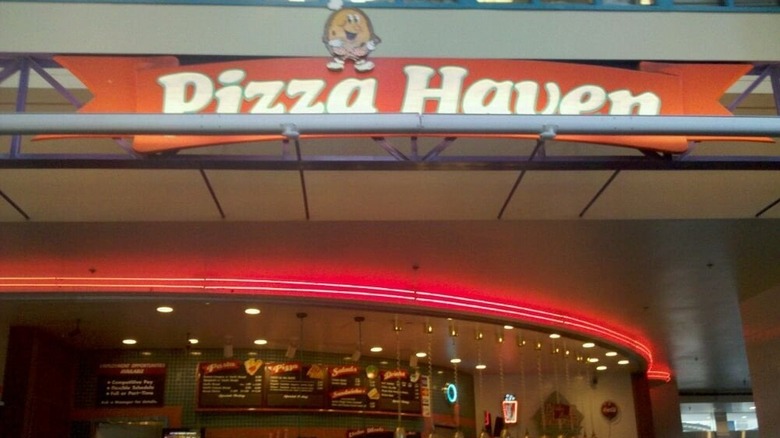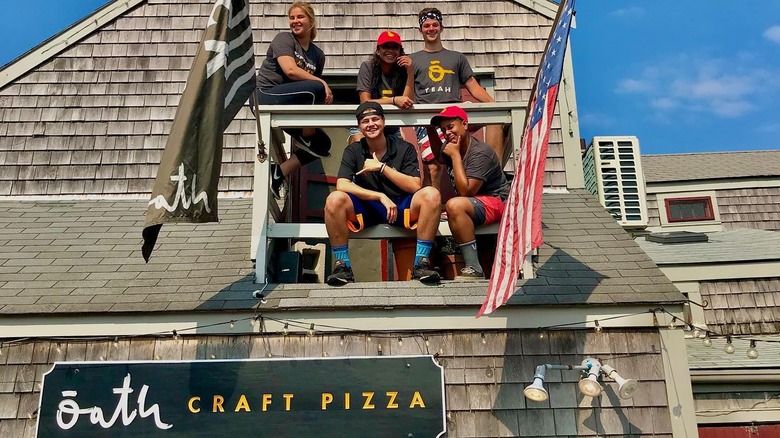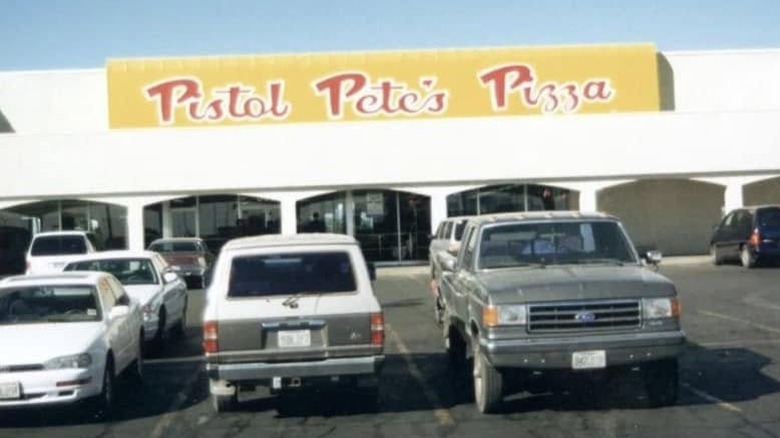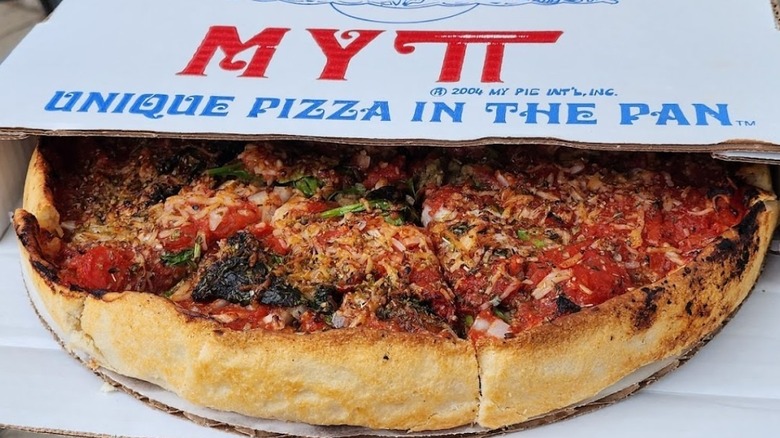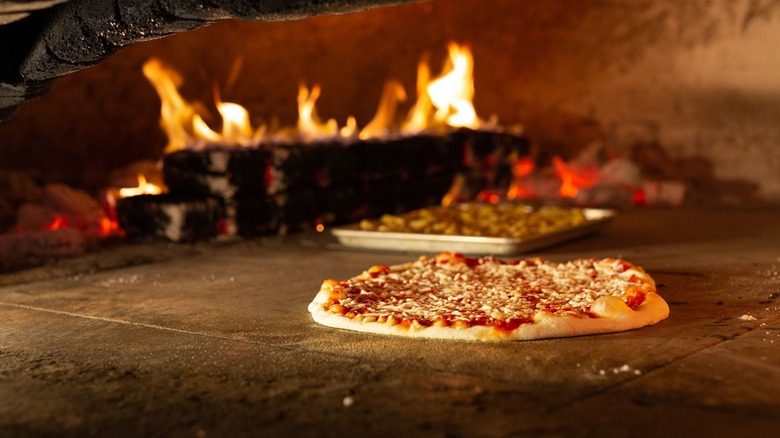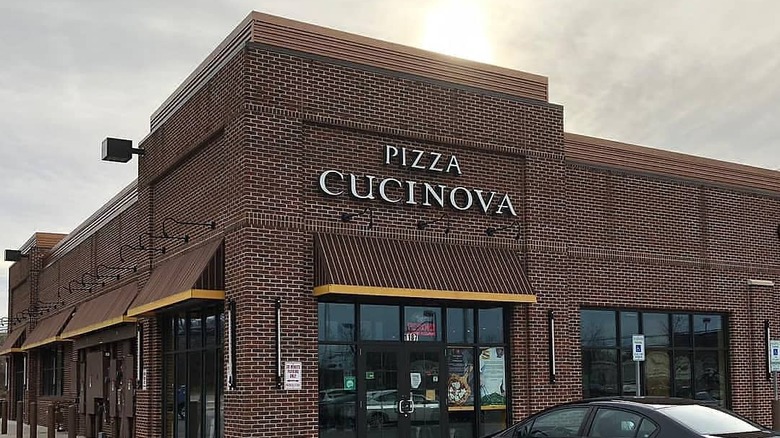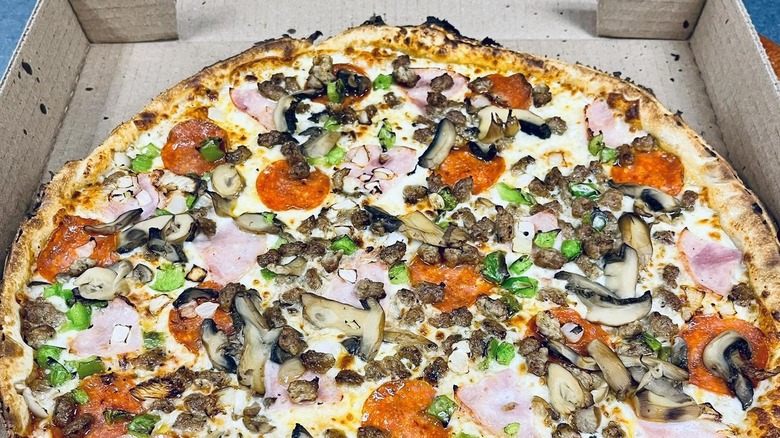Old-School Pizza Chains That Quietly Disappeared
From its Mediterranean connection to pita bread to the arrival of fresh tomatoes to Naples, Italy, in 1760, which transformed pizza forever, pizza's history stretches way back, just like the dough used to make it. Pizza, one of America's most beloved dishes took a while to get here. It's said that Italy's Queen Margherita gave her name to the Margherita pizza, resembling the Italian flag with basil, red sauce, and cheese, during a trip to the city in 1889. Around the same time, homemade pizzas started gaining popularity among Italian communities in places like New Jersey and New York. People were beginning to fall in love with 'za, and it didn't take long for America's first pizzeria, Lombardi's, to open up its doors in Little Italy, New York, in 1905.
Just like old-school breakfast chains, the meteoric rise of the pizza chain happened after World War II, when people had more expendable cash for eating out and were willing to try new cuisine. Shakey's Pizza, Pizza Hut, and Little Caesars all came on the scene in the '50s, but they haven't all been able to navigate rising costs, increased competition, and other issues to remain on everybody's speed dial today.
While you can still get pizza from Lombardi's in Little Italy to this day, many old-school pizza chains have come and gone in the meantime. Here's a roundup of old-school pizza chains that went from slinging dough to shutting up shop.
ShowBiz Pizza Place
The '80s were all about big hair, bold colors, and restaurants with animatronic musical entertainment. One of the strangest old-school restaurants opened its doors for the first time in Kansas City, Missouri, in 1980. ShowBiz Pizza Place introduced Billy Bob Brockali, the hillbilly bear, alongside The Rock-afire Explosion. Diners flocked to the first location to enjoy music, arcade games, and a whole host of classic pizzas like the Cheese Lover, Meatlover, and Showbiz Combo.
While Atari was the pioneer of the family entertainment restaurant opening the first Chuck E. Cheese's Pizza Time Theatre in 1977, it fell foul of the 1983 Video Game Crash and filed for bankruptcy in 1984. Bob Brock, founder of ShowBiz Pizza Place, started the purchase of all the existing units and franchise rights of Pizza Time Theater the same year. The company was renamed ShowBiz Pizza Time and, at its peak in 1985, had a combined 359 stores.
More change was afoot in 1990, when the Rock-afire Explosion was phased out and replaced by Chuck E. Cheese's Munch's Make Believe Band. Eventually, ShowBiz Pizza Place restaurants were also replaced by the name Chuck E. Cheese Pizza, before dropping the "Pizza" in 1994 to leave Chuck E. Cheese, and the rest is history. The animatronic bands that entertained diners in the '80s are only performing at a few legacy Chuck E. Cheese restaurants, such as Pineville, North Carolina, and Northridge, California, these days. And, ShowBiz Pizza Place has gone the way of the '80s chemical perm: extinct.
Shakey's Pizza Parlor
Shakey's Pizza Parlor was once on much more stable ground. The first pizza restaurant franchise in the U.S. was started in Sacramento, California, in 1954 by Sherwood "Shakey" Johnson, who not only claimed to make the World's Greatest Pizza™, but also trademarked the name. Opting for live music from humans instead of robot bears like ShowBiz Pizza Place, the Dixieland ragtime music experience at Shakey's included banjos and pianos. The costumed servers added to the atmosphere, game rooms kept kids entertained, and the pizzas baked in traditional pizza ovens were also a hit.
Shakey's was an immediate hit and started franchising just two years after opening the first location, in 1956. A decade later, in 1967, Shakey's had nearly 300 locations across the country, from California to Maryland, and Sherwood "Shakey" Johnson sold his share in the company for $3 million. Unfortunately, the next few decades were tough for Shakey's. Dedicated customers felt renovations took away Shakey's charm, and menu changes meant the pizza product was lacking, too. Ultimately, Shakey's changed hands several times, leading to closures throughout the '80s and '90s.
There are only 43 Shakey's locations left in the U.S., and all but the one in Washington State are in California. If you really can't live without Shakey's World's Greatest Pizza™ and don't want to go to California, have you considered a move to the Philippines? Shakey's remains the most popular pizza chain in the country with over 300 stores from Manila to Zamboanga City.
Eatza Pizza
The first Eatza Pizza location opened in Scottsdale, Arizona, in 1997. The chain provided pizza enthusiasts with an all-you-can-eat buffet of pizza, pasta, a salad bar, and dessert for a low price. Styled after pizza buffet pioneers Pizza Inn and Cici's, customers could play arcade games between visits to the pizza bar. While the pizzas available varied depending on who else was chowing down at the same time, classic toppings, specials like the Supreme, and dessert pizzas like cinnamon sugar were often on the menu.
While it was never one of the most popular all-you-can-eat chains, Eatza Pizza went through a period of rapid expansion over the next 10 years and grew to 108 locations across 14 states and Puerto Rico. The potential further expansion of the business led to its sale to a private equity group in 2006. Unfortunately, a lawsuit from a restaurant supply company that cited unpaid bills and mass closures led to Eatza Pizza filing for Chapter 7 bankruptcy in 2008 and closing all locations.
The steep rise and rapid decline of this well-liked Scottsdale pizza joint could be due to the difficulties that buffets have with making a profit because of low prices and high wastage, or it could be due to the mismanagement of trying to expand too quickly. Either way, Eatza Pizza is yet another chain that didn't have enough "dough" to stay afloat.
The Organ Grinder
There's definitely a correlation between chains that serve up pizza alongside a musical gimmick and making it onto this list of old-school pizza chains that disappeared, and not-so quietly, in the case of the Organ Grinder. The concept of organ music providing the musical backdrop for pizza eating started with Ye Olde Pizza Joynt, which opened its doors in 1958 and closed for good after a fire in 2003. Combining a slice of pipes with a slice of pizza caught on and led to the pizza and pipes mini renaissance period, including the opening of the Organ Grinder Restaurant in 1973 in Portland, Oregon, and subsequent locations in places like Denver, Colorado, and Vancouver.
In addition to live music from the organs, dancing marionettes, and a light show, customers could also fill the void between slices on a range of arcade games. If this concept sounds familiar, the founder of Chuck E. Cheese, Nolan Bushnell, got the idea for his animatronic band and pizza restaurant from a pizza and pipes restaurant.
While the Organ Grinder no longer exists as a chain, there is one remaining restaurant in the country where you can get your fill of 'za accompanied by organ music: Organ Stop Pizza in Mesa, Arizona. Founded in 1972, this pizza joint boasts the largest Wurlitzer organ in the world, featuring 6,000 pipes.
Straw Hat Pizza
Charlie Olsen and Bill Henderlong opened the first Straw Hat Pizza location in San Leandro, California, in 1960. The unique company name highlights the straw hat that was commonly found in the uniform of workers in pizzerias around the Golden State at the time.
Straw Hat Pizza was a pioneering pizzeria, particularly in its use of local California ingredients, such as local tomatoes in its sauces. The flaky crust pizza was available with various classic toppings, including the Signature Pizza loaded with ham, sausage, pepperoni, and a whole host of veggies. Entertainment came in the form of live music from banjo bands or a piano player, classic movie screenings on the big screen, and the "Charley Horse," a free mechanical kids ride.
The company's motto, "People Pleasin Pizza!", seemed to ring true with Californian locals, and it expanded to 20 stores by 1967. By 1980, there were a combined 230 company-owned and franchised stores. However, Straw Hat Pizza didn't fare so well in the decades that followed. The company changed hands several times, including being sold to Marriott and subsequently acquired by Pizza Hut. The Straw Hat Pizza franchisees fought against Pizza Hut in court to prevent the new owners from requiring them to change their stores to Pizza Hut, and won. However, this victory hasn't improved the overall fate of Straw Hat Pizza, and just 26 locations remain in the U.S., all of which are in California.
Pizza Haven
Italians started moving to Seattle in the early 1900s, predominantly employed in coal mines and as laborers. The city's Rainier Valley neighborhood soon became known as Garlic Gulch, so it's no surprise that many pizza restaurants began to pop up to cater to the local Italian pizza lovers. The first Pizza Haven location opened in Seattle in 1958, offering unpretentious pizzas loaded with a generous amount of toppings, as well as other popular menu items like chicken bisque soup. You could have it all delivered with the company's "dial-a-pizza" service.
At its peak, Pizza Haven had 42 franchises as far away as Russia and the Middle East, with more than 700 employees slinging dough, handling paperwork, and paying bills. Well, they should have been paying their bills. Unfortunately, a missed tax payment by the Pizza Haven owner led to the company's involuntary bankruptcy in 1998. The final location in Seattle's Center House, which survived the original bankruptcy, closed for good in 2012.
Australian pizza lovers may have heard of Pizza Haven. Beginning in 1984, the Australian chain, unaffiliated with the Seattle-based pizzeria, was a big hit down under. Sadly, this Pizza Haven is yet another old-school pizza chain that has quietly disappeared, bought out by Domino's in 2005.
Oath Pizza
If you're reading this, you've probably taken an oath to love pizza forever and always. Oath Pizza was built for people who took the pizza oath. Founded in Nantucket, Massachusetts, in 2015, Oath Pizza was a "new school" pizza chain that quickly rose to popularity thanks to its secret recipe and super-crispy base, achieved by flash-frying in avocado oil. The pizza chain has been quietly disappearing in recent years after an initial steep rise, when branches started popping up around Massachusetts, Washington, D.C., and on the other side of the country in Washington State, reaching a massive 29 locations by 2021.
When a restaurant chain expands this widely and quickly, it's not always a sign of a healthy business. Unfortunately, this proved to be the case for Oath Pizza. Not long after opening several new locations, the company found itself in a massive $50 million debt, ultimately closing corporate operations in 2023 and filing for bankruptcy in 2024.
Oath Pizza purists will still find a couple of franchisee-owned locations still operational in Washington that proudly boast the avocado crusts that were so popular in the early days, but the original location and any other signs of Oath Pizza have disappeared as quickly as the contents of a pizza box in a room full of famished football fans.
Pistol Pete's Pizza
Named after the Oklahoma State University mascot, Pistol Pete, a caricature of gunslinger and Oklahoma-born cowboy Frank Eaton, Pistol Pete's Pizza was a southwestern pizza chain famous for its loaded pizzas, arcade games, and an interactive ordering system that involved large playing cards with the customer's order number on them. Pistol Pete's Pizza opened its first location in Lubbock, Texas, in 1974. It wasn't long before they joined the animatronic band craze that was sweeping pizza joints across the nation, adding Rock-afire Explosion stage shows to the dining experience, and even introducing carnival rides to some locations in the early '90s. From the launch of the first location, the pizza was advertised as hand-tossed and loaded with cheese.
There are several rumors about the founder of Pistol Pete's Pizza, ranging from Peter Piper Pizza franchisees to Frank Cavolo, the son of Tony Cavolo, the founder of Peter Piper Pizza. However, Frank didn't actually join his father's company until 1978. At its height, the chain had 30 locations.
Pistol Pete Pizza's path crossed with Peter Piper Pizza (try saying that tongue twister five times in a row with a mouthful of meat feast) when the Venture West Group, owners of Peter Piper Pizza, bought the chain out and turned all remaining Pistol Pete's Pizza joints into Peter Piper Pizza.
My Pi
Chicago is as synonymous with pizza as New York is with, well, pizza, so here is an ode to pizza pioneers, My Pi Pizza. Several Chicago pizzerias claim to have created the first deep-dish style pizza, with Ike Sewell, the original owner of Pizzeria Uno, having the most substantial claim. My Pi Pizzeria never claimed to be the first, but founder Larry Aronson had been attempting to perfect the deep-dish pizza since the 1950s.
Aronson opened the first location of My Pi in 1971 after perfecting his pizza using California tomatoes that were low in acidity, a specially curated spice blend, cheese from Wisconsin, and fresh dough. The pizzas and good times were a hit among locals, leading to the opening of 25 locations operated by the family and franchisees across nine different states, and introducing deep-dish style pizza to pizza lovers beyond the Prairie State.
Unfortunately, increased competition led to this old-school pizza chain quietly disappearing. The flagship My Pi Pizzeria closed in 2008, and the last remaining My Pi Pizzeria restaurant in Bucktown closed its doors in June 2025. It sadly brings a close to a pizza legacy that spanned more than five decades.
Bertucci's
Bertucci's Brick Oven Pizzeria opened in Somerville, Massachusetts, in 1981. During the early days, the pizzas were based on family recipes and cooked in a brick oven, which added to the authenticity of the brand. The flavors proved a big hit among pizza lovers in and around the city's Davis Square neighborhood. Bertucci's opened two more locations in 1985 and had 21 locations by the time it went public in 1991. After being acquired by N.E. Restaurant Co., Inc., Bertucci's underwent a massive expansion phase, leading to the opening of restaurants in Atlanta, New Jersey, and beyond. At its peak, Bertucci's had more than 80 restaurants.
Yet again, expanding quickly proved to be one of the company's downfalls, along with declining demand among customers for classic family restaurants. Tastes changed, and independent restaurants provided an enticing alternative.
Mass closures followed the years of expansion and Bertucci's filed for bankruptcy for the first time in 2018. Bankruptcy is bad news for any company, but going bankrupt three times in seven years is particularly devastating, and isn't a great sign for the 13 surviving Bertucci's restaurants.
Pizza Cucinova
The story of Pizza Cucinova's fast rise and fall begins with the fast-food pizza chain Sbarro. With 800 locations worldwide, there's no chance of this pizza chain quietly disappearing anytime soon. However, the decision to open a fast-casual joint in the form of Pizza Cucinova proved to be a misstep by the successful outfit. Pizza Cucinova was prototyped in Columbus, Ohio, and proved popular enough that Sbarro decided to open five more locations around Ohio and Texas. The Neapolitan-style pizza with hand-stretched dough was available with a few different sauce options, including classic, red pesto, and creamy parmesan, as well as all the usual toppings, cooked in a wood-fired oven.
Sbarro opened the first location of its fast-casual sister company in October 2013, just two years after filing for Chapter 11 bankruptcy for the first time, emerging from protection the following November. Then, in March 2014, the company filed for Chapter 11 bankruptcy yet again, less than six months after opening Pizza Cucinova. With all the additional financial issues at the company and struggling to create a loyal fan base, Sbarro's side hustle could only stutter along until 2019, when all the locations were shuttered for good.
Despite Sbarro closing its Times Square location the same year it closed Pizza Cucinova, it remains a popular choice in locations that range from the National Zoo in Washington, D.C. to a drive-thru location in England. But, the organization can't say the same for Pizza Cucinova.
Village Inn Pizza Parlor
When foodies hear the words "Village Inn," their minds probably go straight to the once-popular Village Inn breakfast joints that spread from Denver, Colorado, to 116 locations across the country today. However, there was another successful Village Inn founded in North Carolina that, at one point, seemed poised to become a household name as well.
Village Inn Pizza Parlor was founded in 1967, nine years after the breakfast place, and quickly became a popular place to pick up a pie off I-77 in Statesville, North Carolina, the first of 12 locations that founder William "Ray" Lackey Sr. would go on to open in the Tar Heel State. Village Inn quickly became known for its all-you-can-eat pizza buffet, serving pizza, salad, soup, pasta, and dessert pizza for a set price, as well as its unique A-frame architecture.
The recognizable buildings and buffet offerings helped build the brand, leading to the chain opening 70 locations across the South, as well as in states such as Illinois and Ohio. Unfortunately, much like Eatza Pizza, Village Inn Pizza Parlor's buffet style led to less profit and a lot of wastage, especially with rising costs of food. Expansions beyond North Carolina didn't have the same loyal customer base as locations within the state, which explains why the remaining 13 locations and a food truck are all located in North Carolina.
